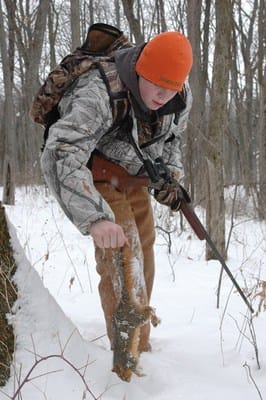
My father, Mick, has for years said that if he were forced to give up all types of hunting, save one, that which he would continue to do would be squirrel hunting. “It’s enjoyable,” he has always said. “It’s relaxing, there are plenty of squirrels, and they’re awful good to eat.”
Personally, I couldn’t agree more with my old man. However, I will take his decades-old statement one step further, and include the words “hunt squirrels in the snow.” Long after many hunting seasons have closed, most states continue to offer their sportsmen the opportunity to chase bushytails. Here in the North, in Iowa where my wife and I now live, and in Ohio, where I spent my formative years, these January and February squirrel seasons typically coincide with a covering of the white stuff, and cold, often bitter temperatures. But am I content to hang up the shooting irons for the year, simply because it’s 20 degrees and snowy? Absolutely not, especially when there are all the fixings for my spectacular Dutch oven squirrel still running around the woods.
The Guns
I’m a .22 Long Rifle or .32 caliber muzzleloader guy when it comes to squirrels, and the late season’s no different. In fact, when the leaves are gone and snow covers the ground, shots at bushytails can prove a bit longer. That’s when I appreciate the additional distance afforded by either my old-school Ruger 10/22, or a tack-driving little Pedersoli black powder rifle in .32 caliber. This isn’t to say my Pop’s bolt-action .410 Mossberg or H & R single-shot, also in .410, won’t do the job. They certainly will. I just don’t want Mister Fox Squirrel feeling too safe and secure out there at 60 yards.

The Gear
Like my choice in firearms, my field gear during the snow season is little different from what I carry in September. A U.S. military compartmentalized pouch in olive drab serves as my shoulder bag. In it, I carry ammunition, extra gloves, Heatmax chemical handwarmers, a small thermos of hot chocolate, toilet paper, and my cell phone. There’s room in there, too, for three or four squirrels. I do wear whites in the snow—pure white slip-over britches, and a lightweight zippered snow-camo jacket that fits overtop my heavier wool coat. A warm neck gaiter, and a blaze orange skull cap, squirrels pay no attention to it and I welcome the safety aspect, round out my clothing. Oh, and a seat cushion. I hate a cold butt! The Tactics
I have two favorite squirrel spots when the snow flies. One is a timber edge along a cut cornfield, and the second is a big oak knob surrounded by old hardwood den trees. Snow and cold makes squirrels hungry, so you’re focusing your efforts on food sources. Often, I will still-hunt until I find a concentration of tracks. Then, I’ll put my rear-end on a seat cushion, pour a cup of hot chocolate, and wait. Sunny days, even with temperatures in the single digits, can see a woods filled with activity. Sure, it’s cold, but your other option is working on that Honey-Do List left from October. And you don’t want to do that, now do you?

The Skinny on Skinning
My father taught me many, many things. Among these things was the one-word secret to skinning squirrels without getting fur on the meat. And that one word? Water.
Today, I know folks who don’t squirrel hunt because they either don’t know how to skin the little critters, or they have become so frustrated with trying to separate squirrel from skin, often ending up with what frighteningly resembles a hairy ballpark frank or my Uncle Bob Ducharme’s back, that they’ve given up the game. It’s a shame, really, because it’s that difficult if you remember one thing, water.
Step 1. With a heavy-bladed knife, remove the head and the tail.
Step 2. Remove all four feet at the wrist, or the first joint. Small tin snips work well for this.
Step 3. Soak the carcass thoroughly under running water. Keep the water running, as it’s an important part of the process.
Step 4. Pinch the hide on the back of the squirrel above the spine between your thumb and forefinger. Using your knife, make a small slice through the hide perpendicular to the backbone. Rinse the knife to remove any hair.
Step 5. Place your first and second fingers of each hand into the cut, and pull in opposite directions. Each half of the hide should pop right off, inside out, just like a glove. Remember to rinse your hands during the process.
Step 6. Cut from stem to stern, remove innards, and rinse. You’re done.







